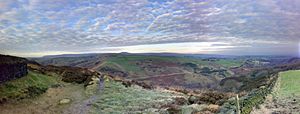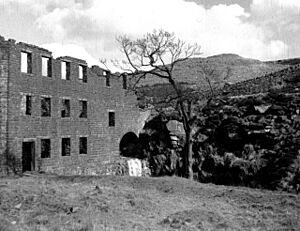Cheesden Valley facts for kids
The Cheesden Valley is a beautiful valley in Greater Manchester, England. It stretches between the towns of Bury and Rochdale. A stream called Cheesden Brook flows through it. This brook eventually joins the River Roch near Heywood. Long ago, during the time of big factories, this valley was important for making cotton. It used the running water from the brook. Today, the Cheesden Valley is a special area that is protected.
Contents
Life Before Factories: The Cheesden Valley's Early Days
Even 10,000 years ago, people were exploring the area around Heywood. Scientists have found small flint tools in the Cheesden Valley. These tools, like arrowheads, were likely left by groups of hunters. They probably used the high ground near water sources.
Later, people farmed the land here. They also made a living by weaving wool from their own sheep. They used a simple machine called a handloom. The very first mills were built to help these weavers. They provided yarn and other services.
Digging for Coal: Mining in the Valley
People started mining in the Cheesden Valley a long time ago. As early as 1580, Queen Elizabeth I gave permission to a man named John Blackwall to mine coal here. It's also thought that in the 1600s, small communities might have had their own little mines.
The Rise and Fall of Mills: Cotton Power in Cheesden Valley
The Cheesden Valley became a busy place during the Industrial Age. This was a time when many factories were built. The first mill in the valley was probably built around 1780. It was a fustian mill, which made a strong cotton fabric. It might have used new machines called Arkwright water frames.
One mill owner, John Haworth, built his Four-Acre Mill high up on the moors. It was powered by a huge waterwheel, about 11 metres tall! He even built a large pond, called a lodge, to make sure his mill and others always had enough water. Before this, mills depended on the weather. Workers might be sent home during dry spells.
Another important mill was Lumb Mill, built in 1786 by John Kay. This mill was a fulling mill. It turned woollen cloth into felted materials, making them thicker and stronger.
The Cheesden Brook was very powerful. It provided energy for at least 15 mills! These mills gave jobs to about 2,000 people. Small communities grew up in what was once a quiet area.
For over 50 years, these moorland mills did well. They found special ways to make money, like spinning cotton waste. This meant they recycled parts of yarn that were usually thrown away. When the American Civil War caused a "cotton famine" (a shortage of cotton), these waste mills actually became very busy!
However, by the 1870s, the mills in Cheesden Valley found it hard to compete. Bigger factories in nearby towns used steam power, which was more efficient. Before the year 1900, almost all the valley's mills had closed down.
Today, you can still see signs of these old mills. You might find parts of old buildings, ponds, and even a chimney. Other old industrial structures like weirs (small dams) and dykes (channels) are also still there. They are a reminder of the valley's busy past.
Mills of Cheesden Valley
Here is a list of some of the mills that once operated in the valley:
- Four Acre
- Cheesden Pasture (built around 1810)
- Lower Pasture
- Cheesden Bar
- Cheesden Lumb Upper
- Cheesden Lumb Lower
- Longlands
- Croston Close Upper
- Croston Close Lower
- Deeply Hill
- Deeply Vale
- Washwheel
- Bircle Dene
- Kershaw Bridge



